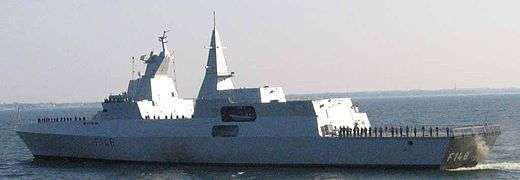SAS Mendi
SAS Mendi (F148) is the last of four Valour-class frigates built for the South African Navy by the European South African Corvette Consortium and entered service in March 2007. SAS Mendi was named by Mrs Helena Retief, wife of the (then) Chief of the Navy Vice Admiral Johan Retief.[1]
 SAS Mendi | |
| History | |
|---|---|
| Name: | SAS Mendi |
| Namesake: | SS Mendi |
| Ordered: | 3 December 1999 |
| Builder: | Howaldtswerke-Deutsche Werft, Kiel |
| Laid down: | 28 June 2002 |
| Launched: | October 2003 |
| Commissioned: | 20 March 2007 |
| Homeport: | Simonstown |
| Identification: | F148 |
| Status: | Active service |
| General characteristics | |
| Class and type: | Valour-class frigate |
| Displacement: | 3,700 tons |
| Length: | 121 m (397 ft) |
| Beam: | 16.34 m (53.6 ft) |
| Draught: | 5.95 m (19.5 ft) |
| Propulsion: |
|
| Speed: | 30 knots (56 km/h; 35 mph) |
| Range: | 8,000 nautical miles (15,000 km) at 16 knots (30 km/h) |
| Complement: | 152 |
| Sensors and processing systems: |
|
| Electronic warfare & decoys: |
|
| Armament: |
|
| Aircraft carried: | 1 × SuperLynx 300 (can carry 2) |
| Aviation facilities: |
|
Construction
Mendi, as with all the Valour-class vessels, was manufactured by the European South African Corvette Consortium (ESACC), consisting of the German Frigate Consortium (Blohm+Voss, Thyssen Rheinstahl and Howaldtswerke Deutsche Werf), African Defence Systems (part of the French Thales defence group) and a number of South African companies.[2]
The ships were built to the MEKO modular design concept, and are designated by the manufacturer as the MEKO A-200SAN class. Some controversy exists as to the class type of the vessel, with both the manufacturer and the South African Navy referring to her as a "corvette", but other similar vessels in other navies being referred to as frigates.
SAS Mendi was built at the Howaldtswerke-Deutsche Werft shipyards in Kiel, Germany,[3] and arrived in South Africa on 20 September 2004.
Namesake
As with all the other ships of the Valour class, Mendi is named after a famous South African battle or instance of great valour. In this case the sinking of SS Mendi in the English Channel during World War I.[4] On the 23 August 2004, en route from the shipyards to South Africa, SAS Mendi and HMS Nottingham,[5] a Type 42 destroyer, met at the site where SS Mendi sank and lay wreaths in remembrance of those who died in service for their country
Notable deployments
- A deployment to Brazil and Ghana from Aug to Sep 2007
- Operation Boniso 2004
- Operational Sea Training Phase training with the German Navy[6]
- Exercising with the French frigate Nivôse off Cape Point
- Conducted Exocet MM 40 missile firings with SAS Isandlwana in 2007
- Exercise Red Lion[7]
- Exercised with HMS Southampton off Cape Town
- On 5 September 2008 Mendi led seven of the South African Navy's newest vessels in a Presidential Fleet Review,[8] the first to be held in South Africa since the 75th anniversary of the Navy in 1997.
- Since 2011, SAS Mendi has intermittently been deployed on anti-piracy operations in the Mozambique Channel as part of Operation Copper. All four Valour-class frigates, SAS Drakensberg, and two of the SAN's offshore patrol vessels (OPVs) have intermittently spent time on station since the operation began.[9]
References
- South African Navy Ships Archived 2011-12-25 at the Wayback Machine
- MEKO A Class Combat Ship Family - Naval Technology
- Valour-class Frigates
- SS Mendi History
- Memorial Wreathlaying
- Operating The New Patrol Corvettes Of The Sa Navy
- Planned Exercises for the South African Navy for the Period 2011 - 2013
- Presidential Fleet Review from the South African Air Force
- Martin, Guy. "Operation Copper now only with SA and Mozambique". defenceweb.co.za. defenceweb. Retrieved 19 July 2014.
External links
| Wikimedia Commons has media related to F148 Mendi (ship, 2007). |
- Photos of F148
- Valour class entry at South African Navy website